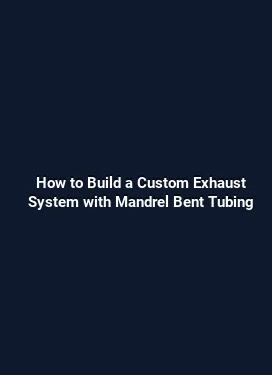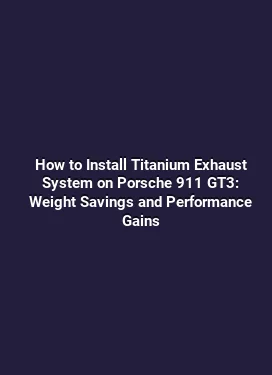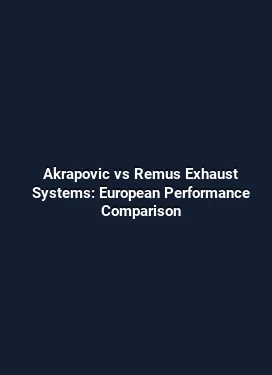Stainless Steel vs Titanium Exhaust Materials: A Comprehensive Comparison for Performance, Durability, and Cost
Material Characteristics and Basic Properties

Exhaust systems are engineered to balance several interdependent factors: heat management, weight, strength, corrosion resistance, and cost. Stainless steel and titanium represent two of the most popular options in aftermarket and OEM exhaust assemblies. Stainless steel typically comes in grades like 304 and 409, with 304 offering good corrosion resistance and ease of fabrication, while 409 is a more economical option often used in mass-market applications. Titanium, by contrast, is renowned for its high strength-to-weight ratio and exceptional corrosion resistance in certain environments, albeit at a premium price. Understanding the fundamental properties of these materials lays the groundwork for evaluating real-world performance and ownership considerations.
Weight savings translate directly into handling and responsiveness on the track or street. Titanium’s density is about one-third that of stainless steel, which means a titanium exhaust can significantly reduce the vehicle’s unsprung mass. This reduction has cascading benefits for throttle response, suspension dynamics, and overall acceleration. However, the material’s workability, bending, and welding requirements are more demanding, often driving up fabrication time and costs. Stainless steel, while heavier, is more forgiving in the fabrication process and generally provides consistent results across a broader range of service conditions.
Corrosion Resistance and Environmental Exposure
Corrosion resistance is a critical factor for any exhaust system, given high-temperature cycling, road salts, moisture, and exhaust gases. Stainless steel forms a robust passive layer that resists oxidation under typical automotive conditions. Grade selection matters: 304 stainless steel offers strong corrosion resistance in normal environments, while 409 is tailored for cost efficiency with acceptable performance in heat and humidity. Titanium, when properly alloyed and protected, delivers superior corrosion resistance in extreme environments, including coastal or highly humid climates where chloride exposure is a concern. Nevertheless, improper coating or welding can introduce pitting or crevice corrosion, particularly in aggressive vehicle setups or improper maintenance scenarios.
Beyond atmospheric exposure, temperature extremes influence long-term durability. Titanium maintains strength and stiffness at higher temperatures more effectively than stainless steel, reducing the risk of thermal fatigue under demanding driving scenarios. This advantage is especially noticeable in high-performance applications where exhaust gas temperatures spike during spirited driving or forced induction setups.
Heat Management and Expansion

Exhaust systems must manage thermal expansion and contraction without compromising joints or hangers. Stainless steel expands and contracts at a known rate, which can be accommodated through well-designed hangers and slip joints. Titanium’s lower thermal mass means it heats up and cools down more quickly, a property that can influence gasket performance and joint integrity if not engineered precisely. In high-stress environments, titanium’s reduced thermal cycler can contribute to improved resilience, but this benefit hinges on meticulous fabrication and consistent quality control.
For enthusiasts valuing aggressive tuning or track use, heat management also intersects with muffler design and pipe diameter. Larger diameters favor flow at higher RPMs but may introduce resonant characteristics at lower speeds. A balanced approach considers material properties alongside acoustical goals to minimize backpressure while preserving engine efficiency.
Weight, Strength, and Structural Integrity
The weight differential between stainless steel and titanium is substantial. A typical titanium exhaust component can weigh 40–60% less than its stainless steel counterpart, depending on thickness, wall design, and overall geometry. This weight reduction influences the car’s weight distribution, tire loading, and brake performance, especially on lightweight sports cars and performance sedans where every kilogram matters. In terms of strength, titanium offers exceptional tensile strength for its mass, maintaining stiffness under high-load conditions. Stainless steel provides robust structural integrity with excellent fatigue resistance when properly heat-treated and finished, making it a dependable choice for a broad range of vehicles and user profiles.
Practical considerations include the potential for galling and galling resistance when fasteners and joints are mated with dissimilar metals. Proper anti-seizant coatings or refractory compounds at mating surfaces can help preserve joint integrity over many thermal cycles. For owners who frequently assemble and disassemble exhaust components for maintenance or track sessions, ease of service becomes a notable factor in material selection.
Efficacy in Acoustic Tuning
Exhaust acoustics are a nuanced product of pipe geometry, muffler design, and material interactions. Titanium’s lighter mass can alter the frequency response of the system, contributing to a crisper, more metallic tone in some configurations. Stainless steel systems often yield a deeper or raspier character, depending on pipe diameter, muffler packing, and internal baffling. From a practical standpoint, the material choice can influence the perceived tone, but the final sound signature is also shaped by the muffler’s packing material, perforation pattern, and overall resonance control. For street-driven cars, a balanced tone that remains within noise regulations while delivering a satisfying exhaust note is often achieved through a combination of geometry and material choice rather than relying on a single element alone.
Cost Dynamics: Purchase Price, Longevity, and Maintenance
Price is a primary consideration for most buyers. Stainless steel exhaust systems present a more approachable entry price, with varied options across OEM replacements, aftermarket cat-back kits, and performance-oriented stainless assemblies. Titanium systems command a premium due to raw material costs, manufacturing complexity, and limited supplier ecosystems. In many cases, the price difference can be substantial, prompting buyers to weigh the performance gains against the budget impact.
Ownership cost extends beyond the initial purchase. Maintenance and potential repairs differ between materials. Stainless steel can be repaired with conventional welding techniques and is generally easier to source replacement parts for, given its wider use in the automotive market. Titanium, while exceptionally durable, may require specialized services for repairs, and certain suspension or hangar components may need custom fittings or coatings to ensure compatibility over time. For vehicles used in harsh climates or with frequent track exposure, a proactive maintenance plan—such as regular inspections of weld seams and hangers—helps preserve performance characteristics and prevent unexpected downtime.
Value Proposition Across Different Use Cases
For daily drivers seeking a practical balance between cost and performance, stainless steel exhausts provide dependable service with reasonable longevity and straightforward serviceability. For enthusiasts chasing performance advantages, track reliability, and a lighter overall system, titanium presents an appealing opportunity when the budget allows. In showroom-to-track scenarios, consider the entire system architecture, including mounting hardware, sensors, and catalytic elements, as upgrades in one area can influence performance in another. A well-matched combination of components—such as a lighter mid-pipe or a tuned muffler—can unlock a blend of power, responsiveness, and sound without compromising long-term reliability.
Installation Considerations and Fitment Nuances
Compatibility and fitment are critical to maximizing the benefits of either material choice. Titanium exhausts often require precise tolerances and high-quality hardware to avoid misalignment after heat cycles. Some vehicles with complex chassis geometries may benefit from bespoke fabrication or dealership-backed configurations to ensure a proper seal and clearance from heat-sensitive components. Stainless steel assemblies, thanks to their versatility and availability, tend to offer more forgiving fitment in a wide range of model years and trims. When selecting an exhaust kit, verify that hangar spacing, flange compatibility, and overall length align with the vehicle’s original specifications and any aftermarket components that are already installed.
Another practical aspect is supplier assurance. Reputable manufacturers provide detailed specifications for wall thickness, pipe diameter progression, and connection standards. This transparency helps buyers anticipate performance characteristics and potential maintenance needs. In addition, many brands offer expansion options like resonators or alternative muffler configurations that can tailor the acoustic profile while preserving or enhancing flow characteristics.
Real-World Scenarios: Performance, Sound, and Durability
Consider a mid-engine sports car used for weekend track events. A titanium exhaust system can contribute to noticeable weight reduction, potentially improving throttle response and handling due to lower inertia. However, the benefits are maximized when paired with a similarly engineered intake and exhaust manifold setup to optimize exhaust gas flow. For a daily driver, a stainless steel cat-back system may provide a good balance of performance, durability, and cost, with a sound that remains within typical street noise allowances while still delivering a satisfying note under acceleration.
In high-humidity coastal environments, the corrosion resistance of titanium can translate into longer intervals between maintenance sessions, provided the system is free of micro-damage from impact or improper installation. Conversely, in regions with aggressive road salt usage, stainless steel with proper coatings and anti-corrosion treatments can offer comparable longevity at a lower total cost of ownership.
Maintenance Strategy and Longevity Planning
Maintenance strategies influence long-term performance and total ownership costs. Regular inspection of exhaust joints and clamps helps prevent leaks that can degrade performance and sound quality. For titanium systems, monitoring for any signs of coating wear or surface pitting is prudent, especially around weld seams or areas exposed to salt and moisture. Stainless steel systems benefit from periodic cleaning to remove road residues that could accelerate surface corrosion, particularly on uncoated areas near the exhaust tip or joints.
Cleaning routines should be tailored to the exhaust’s finish. Brushed or polished stainless steel surfaces may require gentle polishing agents to maintain their appearance, while titanium finishes may be more sensitive to abrasion and chemical cleaners. When in doubt, follow the manufacturer’s maintenance guidelines to preserve the material’s protective layers and aesthetic appeal over time.
Warranty and Aftermarket Support
Warranty terms can differ significantly between stainless steel and titanium exhaust systems. Stainless steel products often come with longer, more accessible warranties due to the material’s established manufacturing processes and broader market availability. Titanium warranties may be more restricted or tied to specific usage conditions, such as limited track use or non-abusive mounting practices. Assess warranty coverage not only for the material but also for critical components like gaskets, hangers, and sensors, which can influence the overall reliability of the installation.
Conclusion: Making an Informed Choice
A nuanced evaluation of stainless steel and titanium exhaust materials reveals a spectrum of trade-offs. Weight savings, heat handling, and corrosion resistance vary with each option, shaping performance outcomes and long-term durability. For those who prioritize cost-efficiency, durability in everyday driving, and straightforward service, stainless steel remains a practical and widely supported choice. For enthusiasts seeking a lighter system with exceptional strength and resistance to high-temperature cycling, titanium offers compelling advantages when the budget and fabrication expertise align with the project goals. The final decision should consider vehicle type, usage profile, climate exposure, and maintenance plans to ensure that the chosen material contributes to the intended performance and ownership experience. Frequently Asked Questions






